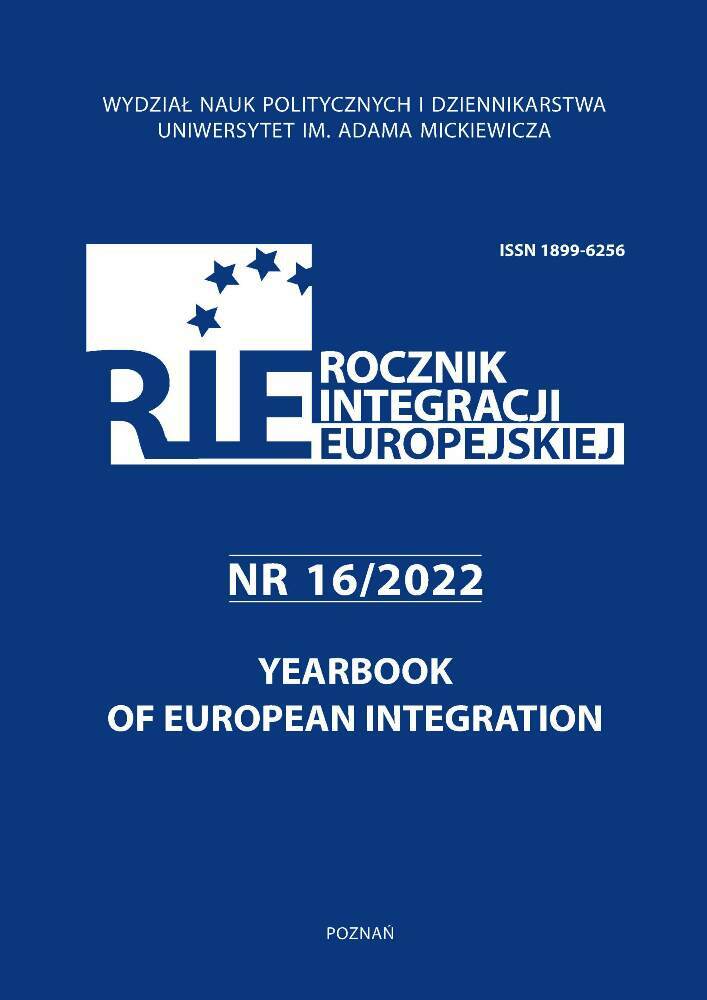Abstract
This article presents the historical determinants of the contemporary foreign policy of the Republic of Finland. Despite its low economic and military potential, the state managed to maintain in dependence and relative independence both during World War II and the Cold War. Finland’s contemporary geopolitical situation and the way it conducts its international policy stems from a long tradition of balancing its relations with major players on the international stage. The aggression of the Russian Federation towards Ukraine made it necessary to change this policy and enter the structures of the North Atlantic Treaty.
References
ACT concerning the conditions of accession of the Kingdom of Norway, the Republic of Austria, the Republic of Finland and the Kingdom of Sweden and the adjustments to the Treaties on which the European Union is founded, Contents (1994), https://eurlex.europa.eu/legalcontent/EN/TXT/HTML/?uri=CELEX:11994N/TXT&from=PL, 14.09.2022.
Alapuro R. (1988), State and Revolution in Finland, Berkeley.
Allardt E., Miemois K. J. (1981), The Swedish Speaking Minority in Finland, Helsinki.
Arter D. (1987), Politics and Policy-Making in Finland, New York.
Barton H. A. (1986), Scandinavia in the Revolutionary Era, 1760–1815, Minneapolis.
Christiansen E. (2009), Krucjaty północne, Poznań.
Cieślak T. (1983), Historia Finlandii, Wrocław.
Czarnotta Z., Moszumański Z. (1994), Wojna Zimowa, Warszawa.
Czechowski J. (2009), Polska i Finlandia – stosunki dwustronne w latach 1918–1939, Toruń.
Denkiewicz-Szczepaniak E. (1999), Polska siła robocza w Organizacji Todta w Norwegii i Finlandii w latach 1941–1945, Toruń.
Elman C., Elman M. F. (2001), Introduction: Negotiating International History and Politics, w: Bridges and Boundaries: Historians, Political Scientists, and the Study of International Relations, red. C. Elman, M. F. Elman, Cambridge.
Encyklopedia Britannica, Treaty of Moscow, http://www.britannica.com/EBchecked/topic/1356613/Treaty-of-Moscow, 13.03.2021.
Encyklopedia Britannica, Russo-Finnish war, http://www.britannica.com/EBchecked/topic/514007/Russo-Finnish-War, 13.03.2021.
Filipek M. J. (2011), Międzynarodowoprawny status archipelagu Wysp Alandzkich. Kwestia demilitaryzacji i neutralizacji Alandów, „Kwartalnik Kolegium Ekonomiczno-Społecznego Studia i Prace / Szkoła Główna Handlowa”, nr 1, Warszawa. DOI: https://doi.org/10.33119/KKESSiP.2011.1.6
Fingerroos O. (2012), „Karelia Issue”: The Politcs and Memory of Karelia in Finland, w: Finland in World War II: History, Memory, Interpretations, red. T. Kinnunen, V. Kivimäki, Boston.
Fonkowicz J. (1976), O czym śpiewają kantele, Warszawa.
Fotokopia Tajnego Protokołu Paktu Ribbentrop–Mołotow, http://www.montclair.edu/chss/english/furr/research/mlg09/m-rpact.html, 13.03.2021.
Goodman J. W. (2006), Telecommunications Policy-making in the European Union, Norhampton. DOI: https://doi.org/10.4337/9781847201690
Grochmalski P. (2020), Dugina podbój Europy, „Gazeta Polska”, nr 416.
Gulan A., Haavio M., Kilponen J. (2021), Źródła wielkiego kryzysu fińskiej gospodarki, https://www.obserwatorfinansowy.pl/tematyka/makroekonomia/trendy-gospodarcze/zrodla-wielkiego-kryzysu-finskiej-gospodarki/, 12.09.2022.
Hanhimäki J. M. (1988), Security and Identity: the Nordic Countries and the United States since 1945, w: No End to Alliance: The United States and Western Europe: Past, Present and Future, red. G. Lundestad, New York.
Hentilä S., Jussila O., Nevakivi J. (1995), Suomenpoliittinenhistoria 1809–1995, Porvoo.
Himmelfarb G. (2004), The New History and the Old: Critical Essays and Reappraisals. Revised Edition, London.
Hoffer P. C. (2008), The Historians’ Paradox. The study of History in Our Time, New York.
Jakobson M. (1998), Finland in the new Europe, Westport.
Jayapalan N. (2008), Historiography, New Delhi.
Jornonen O., Settlement of Finland Begins, http://uralica.com/earlyfin.htm, 14.03.2021.
Jowett P., Snodgrass B. (2010), Finlandia w wojnie 1939–1945, Warszawa.
Jurasz W. (2022), Demony Rosji, Warszawa.
Jussila O., Hentilä S., Nevakivi J. (2001), Historia polityczna Finlandii 1809–1999, Kraków.
Kaczmarek K. (2021), Depopulacja i starzenie się społeczeństw jako przedmiot badań nauk społecznych na przykładzie fińskiej Laponii, „Acta Politica Polonica”, nr 2. DOI: https://doi.org/10.35467/cal/133993
Kekkonen U. (1983), Nie szukajcie przyjaciół daleko, a wrogów blisko, Warszawa.
Kirby D. (2006), A Concise History of Finland, Cambridge. DOI: https://doi.org/10.1017/CBO9781107280229
Kovisto M. (1997), Witness to history: the memorisMaunoKoisvisto president of Finland President of Finland 1982–1994, Carbondale.
Kuczkiewicz-Fraś A. (2012), Język jako determinant tożsamości narodowej i państwowej w Pakistanie i Bangladeszu, „Politeja. Pismo Wydziału Studiów Międzynarodowych i Politycznych Uniwersytetu Jagiellońskiego”, tom 20/2, nr 2/2, Kraków.
Mawdsley E. (2010), Wojna domowa w Rosji 1917–1920, Warszawa.
Moczulski L. (2010), Geopolityka. Potęga w czasie i przestrzeni, Warszawa.
Niinistö J. (2005), Heimosotienhistoria 1918–1922, Helsinki.
Nygård T., Itä-KarjalastaSuomeen 1917–1922 tulleetpakolaiset, dostępne na witrynie internetowej Fińskiego towarzystwa Genealogicznego: https://www.genealogia.fi, 14.03.2021.
Okulicz-Kozaryn Ł. (1993), Finowie zachodni, Warszawa.
Pawłuszko T. (2013), Wstęp do metodologii badań politologicznych. Skrypt akademicki, Częstochowa.
Pokój Moskiewski 1940, http://www.winterwar.com/War%27sEnd/moscow_peace_treaty.htm, 13.03.2021.
Rezolucja Ligi Narodów z 14 grudnia 1939 roku, http://www.histdoc.net/history/league1.html, 14.03.2021.
Sakkov S. (2014), Towards Nordic-Baltic defence cooperation: a view from Estonia, w: Northern Security and Global Politics: Nordic-Baltic Strategic Influence in a post-unipolar world, red. A. S. Dahl, P. Järvenpää, Abingdon.
Sariola S. (1982), Finland and Finlandization, „History Today”, vol. 32, http://www.historytoday.com/sakari-sariola/finland-and-finlandization, 14.03.2021.
Singleton F. (1985), Finland’s Functioning „Finlandisation”, „World Today”, nr 11 listopad.
Singleton F. (1981), The Myth of „Finlandisation”, „International Affairs [London]”, nr 2, London. DOI: https://doi.org/10.2307/2619164 DOI: https://doi.org/10.2307/2619164
Söderhjelm H. (1919), The red insurrection in Finland in 1918, a study based on documentary evidence, London.
Solsten E., Meditz S. W. (1988), Finland: A country of study, http://countrystudies.us/finland/25.htm, 14.03.2021.
Sondaż: Większość Szwedów chce przystąpienia do NATO, (2022), „Rzeczpospolita”, 22.04.2022, https://www.rp.pl/spoleczenstwo/art36119881-sondaz-wiekszosc-szwedow-chce-przystapienia-do-nato, 22.09.2022.
Statistics Finland, http://tilastokeskus.fi/hae_en?word=trade&sort=inv_aika, 13.03.2021.
Suchoples J. (2002), Finlandia w polityce Stanów Zjednoczonych 1917–1919, Warszawa.
Szordykowska B., (2011), Historia Finlandii, Warszawa.
Szymczyński T. (red.) (2009), Negocjowanie granic: od „dwunastki” do „piętnastki”. Rozszerzenie północne Unii Europejskiej (1994). Austria, Szwecja i Finlandia w UE, Poznań.
Tacyt P. K. (2008), Germania, Poznań.
Wuorinen J. H. (1948), Finland and world war II 1939–1944, New York.
Żmudzki, J. (1988), Finlandia w polityce mocarstw 1939–1944, Przemyśl.
License
Copyright (c) 2022 Czesław Partacz

This work is licensed under a Creative Commons Attribution 4.0 International License.

